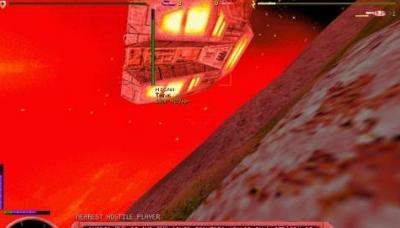Wulfram II (0)

Overview
Wulfram II was originally developed by Total Entertainment Network and Shockforce in the late 90s as "Shockforce" but was never published. It was later picked up by game developer Bernt Habermeier (Slurpy) and released in 2002 under his company Slurpysoft as "Wulfram II."
The objective of each match was to defeat the enemy team by destroying all base structures and players on the map. There were two teams, the Azure Alliance and the Crimson Federation. Each team could have up to 32 players. There was no upper or lower time limit on a match length and they could last as little as a few minutes or as long as several days.
Wulfram II featured hybrid first-person shooter and real-time strategy gameplay. Players control a hovertank class, either a Tank or a Scout (Medic), and pilot it across 3-Dimensional terrain. Each team starts the match with one Uplink device which can be used to control up to three Starships that float far above the battlefield. Starships could occupy one section of an 6x6 grid that encompasses the entire map, only one Starship could occupy a grid space at a time (without exploiting game mechanics). Starships were used to drop deployable base equipment, destroy other starships, or to bombard enemy tanks and base structures inside the same grid as the Starship. Successful use of the Uplink device to control your Starships might be the difference between a victory or a defeat, but winning a match is still possible if it is not used.
The game featured two types of hovertanks that each feature a health pool and an energy pool. Energy was used when firing the main and secondary weapons of either hovertank and could be recharged quickly by landing on the ground or at a resupply station. The primary class was the "Tank," a slow but powerful vehicle with the ability to jump high in the air. The Tank was the only class able use the Uplink device, deploy base structures, and use a myriad of secondary weapons available from deployed supply stations. The Tank featured an autocannon as it's primary firing weapon as well as a heavy, single fire cannon as a secondary weapon which used a large amount of energy to fire. The second class is the "Scout," a fast, nimble, but frail vehicle used primarily as a medic. Scouts can heal base structures and tanks, as well as use their healing beam to damage enemy tanks.
Wulfram II featured a leveling system that was used, primarily, to guide new players through the game's steep learning curve. Levels could only be granted by "Trainers" who were volunteers from the game's community. Beginners to the game had to play on a server for levels 1-6, and were granted levels by Trainers after it was clear they displayed a basic understanding of the game. This was usually determined by a Trainer issued challenge or test. All players level 7+ could play on the same servers and would continue to be granted levels until they reached level 11. At level 11 all players were expected to have mastered the games mechanics and were allowed to play on a special server made only for Level 10/11 players. Players were leveled from 9 directly to 11, skipping 10 entirely because level 10 was granted only to players who were considered "veterans" of the game and who had played before the launch of wulfram.com.
Wulfram II was released as free-to-play but developer Slurpy asked for donations to keep the game going. Donations were used to maintain and upgrade game servers as well as partially fund periodic updates to the game. The game maintained a moderately sized community for several years after initial release but never achieved mass popularity. In 2010 all Wulfram servers were shut down and wulfram.com was taken down. When asked on about why the game was suddenly shut off Slurpy replied: "The deal with Wulfram is that it's just about 15 years old. The downfall of the game was that it wasn't a financial success. Ever." Source code for the game was never made public.


